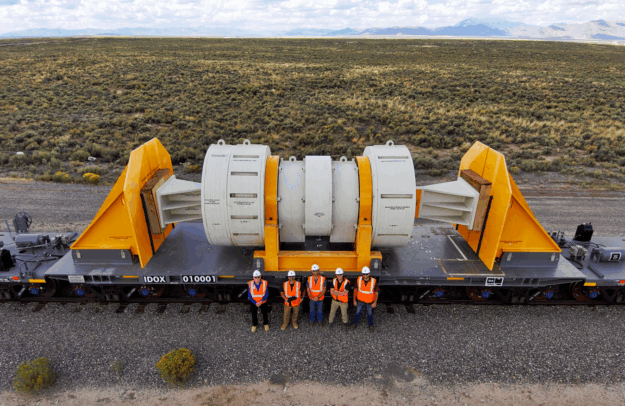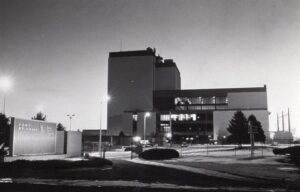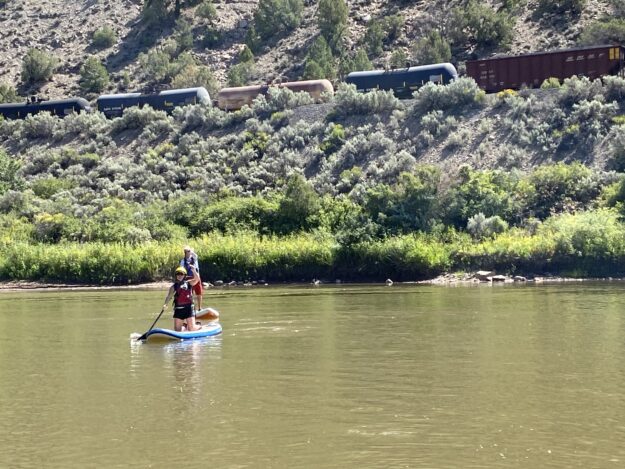Widgetized Section
Go to Admin » Appearance » Widgets » and move Gabfire Widget: Social into that MastheadOverlay zone
Northwest Colorado explores nuclear waste storage with rail connectivity

An Atlas nuclear waste railcar (U.S. Department of Energy photo).
Colorado has a long, dark history of failed and still highly toxic nuclear energy and weapons projects around the state, but the demand for carbon-free energy to combat climate change and fuel the booming tech sector has launched a bipartisan push for a nuclear energy renaissance.
From the Rocky Flats weapons facility on the Front Range to the buried Superfund uranium ghost town of Uravan in the west, Colorado is a Cold War graveyard born of the nuclear arms race. A nuclear bomb was even detonated for the peaceful but misguided purpose of fracking gas at the I-70 fly-by exit of Rulison in Garfield County, while spent fuel rods are the lasting legacy of Ft. St. Vrain, the state’s lone, somewhat experimental and ultimately short-lived nuclear power plant.
But as the state systematically shuts down coal-fired powerplants from Pueblo to Craig – both to reduce carbon emissions and to utilize renewable sources, natural gas and battery storage that’s now cheaper than coal – there’s recognition by politicians on both sides of the aisle that lofty carbon-free climate goals may not be achievable without nuclear power.

“It’s got to get powered somehow,” Democratic state Sen. Dylan Roberts said of the power-hungry tech sector. “I’m pretty all-of-the-above approach in how we figure that out. People might not want data centers, but most of those folks rely on what those data centers provide, and so hopefully we can power a lot of that with solar and wind — huge supporter of that — but I don’t think we’ll be able to power everything with just solar and wind. So something that doesn’t emit carbon [nuclear power], if we can deal with the safety impacts and the local support, that’s much better than burning more natural gas or some other type of non-renewable energy source.”
“All of the above” used to primarily be a Republican rallying cry for keeping the 24-hour reliability of fossil fuels at the forefront of the state’s energy mix despite the warming effects of greenhouse gas emissions. Now it’s come to encompass everything from hydro power to geothermal and, increasingly, nuclear power.
Roberts successfully sponsored a bipartisan bill this past legislative session called “Adding Nuclear Energy as a Clean Energy Resource”. HB25-1040 drew the ire of environmentalists who unsuccessfully pushed for Colorado Gov. Jared Polis to veto the legislation.
“Since nuclear energy projects are not prohibited under current Colorado law, I expect the net effects of the passage of HB-1040 to be mostly focused on increased funding opportunities for nuclear projects in Colorado, and a corresponding reduction in available incentives for other clean energy technologies, such as wind and solar,” Joel Johnston, a Denver-based partner at the national law firm Hall Estill, wrote in an email.
“The fact remains that long-term radioactive waste management is a huge ongoing issue for the nuclear power industry, which this bill does nothing to address. Further, no other restrictions or regulations are removed,” adds Johnston, who specializes in environmental and regulatory issues and large infrastructure projects. “So, my view is it will likely make certain clean energy incentives in Colorado more competitive, which would be likely to result in a negative impact to the funding otherwise available to solar, wind or geothermal projects.”
Roberts says one of the reasons he got behind the nuclear as clean energy bill after Republicans tried and failed to get it passed in previous sessions is that his research indicates nuclear power facilities are operating safely in 28 other states, with safe storage of spent fuel on site in several locations. Also, he voted for 100% decarbonization of Colorado’s power supply in 2019, which means no company will invest in any infrastructure that doesn’t qualify as clean energy.

“We’re not talking about the days of Three Mile Island or Chernobyl or even Fukushima,” Roberts said, referencing infamous U.S. and global nuclear disasters. “Small, modular reactors are potentially a viable source in the future that come with significantly less waste and less water usage and could be a viable installation somewhere in Colorado.”
But Johnston counters, “Any rational, workable solution to the long-term radioactive waste dilemma would change more than anything in terms of the likelihood of future new utility scale nuclear generation in Colorado.”
Enter Roberts’ political opponent from his last election. Former Eagle Town Council member Matt Solomon – a Republican who lost to Roberts by more than 25 percentage points in 2022. Solomon is now project manager of the Northwest Colorado Energy Initiative (NCEI), a project of regional governments looking to transition from coal-based economies. It has been somewhat quietly assessing the appetite in northwest Colorado for nuclear waste storage.
According to reporting in the Colorado Sun in January, “Solomon is purposefully trying to avoid drawing lots of public attention to his early conversations about nuclear waste storage.” He did not return a text, email and phone call requesting comment for this story, but during his 2022 state senate campaign he told RealVail.com that “climate change is caused by many factors, not just the ongoing burning of fossil fuels. I have real-world experience in helping to combat climate change.” He went on to describe his climate action on the Eagle Town Council.
“Yeah, I’ve had a few conversations with Matt Solomon,” Roberts confirmed. “I haven’t been involved in any of their programming, and they didn’t consult on [the nuclear as clean energy] bill. Waste storage is not necessarily nuclear energy development. Waste storage could be in and of itself its own thing, and that would definitely have to still get total community buy-in and all the local approvals.”
It would also require federal approval from a Trump administration that is fast-tracking uranium mining, milling and nuclear power plants, which currently provide about 18% of the electricity in the United States with aging reactors and no central waste repository after the failure of the Yucca Mountain project in Nevada. Trump’s DOGE cost cutting initially slashed critical nuclear weapons regulators before reversing course – a move that drew the ire of atomic scientists.
“These are major issues [with nuclear], and the reality is energy policy goes back and forth with administrations and business is planning years out,” energy attorney Johnston said. “With regards to the potential storage facility in northwest Colorado, I take no position on it at the end of the day. Since there’s not been one proposed, that’s hard to be against it, just on principle.”
Trump’s attempted nuclear regulatory rollback apparently has not dampened enthusiasm in the ruby red rural Colorado counties of Moffat and Rio Blanco, where Solomon is making the rounds to replace coal mining and power plant jobs with spent fuel storage, but water and waste issues loom. Roberts said people want to be part of what’s next in the nation’s energy transition.
“What I’ve heard from the constituents I represent, and Hayden and Craig and the people who work in the coal mines and coal power plants there is, they want to continue to be energy generating communities, and they have the infrastructure, they have the transmission lines, and they have the workforce to do that,” Roberts said. “But they’re trying to figure out what that next energy type is. Hayden is pursuing geothermal. Craig might be pursuing natural gas, but there are some people in the community that would like to have nuclear be a part of that conversation.”
Nuclear waste storage will indeed be part of the conversation June 25 in Rifle, at the next monthly board meeting of the Associated Governments of Northwest Colorado, which administers Solomon’s NCEI project. According to the agenda, the Department of Energy’s Office of Nuclear Energy is sending the directors of its Consent-Based Siting Process, Marla Morales and Stephanie Weir, to give a presentation to the board. The DOE website explains that the consent-based siting is used “to identify one or more federal consolidated interim storage facilities for the nation’s spent nuclear fuel.”
Earlier this year, the Steamboat Pilot reported on a Craig City Council meeting at which Solomon said he and county commissioners from Moffat and Garfield counties met with Morales in Washington, D.C., where they discussed a potential storage site near Maybell, about 32 miles west of Craig.
Another critical piece of infrastructure is Union Pacific’s rail line through the area, where the company currently transports coal to the Hayden and Craig powerplants but reached out to the state to facilitate passenger service with the pending plant closures. Could the nation’s next generation nuclear waste railcars someday ride the line to a waste storage facility? Roberts passed a bill last year to incentivize other forms of freight as well as passengers on the line.
“I would probably put that in the way too speculative category, at least at the moment,” Roberts said of nuclear waste by rail. “First of all, the Craig all the way to Denver line or elsewhere is still not quite operational, at least not for passengers and other types of freight other than coal. So a lot of improvements still need to happen before that’s happening. And then, as far as transporting nuclear waste, that comes with a whole set of federal regulations that would have to be complied with first before a company would qualify for any state tax credit.”
Union Pacific spokesperson Mike Jaixen would not directly address moving nuclear waste on UP’s line between Craig and Denver, but he did that say that “Union Pacific invests roughly $10 million per day in infrastructure, technology and network expansion to address the evolving needs of our customers and pursue growth opportunities. We are open to exploring long-term growth solutions with our customers and the communities where we operate.”
A former Amtrak Winter Park Express ski train conductor estimates Union Pacific’s rails between Grand Junction and Denver are at about 30% capacity since coal’s heyday in the 1980s and 90s when about 30 trains a day went back and forth through the Moffat Tunnel. These days there are about six oil trains a day, plus a handful of passenger trains, and that number could quintuple if the Uinta Basin Railway in Utah is built following a recent Supreme Court ruling. Lawyers fighting that project say they expect an executive order from President Donald Trump fast-tracking that oil-train project as soon as next week.
Editor’s note: This story first appeared on the Colorado Times Recorder website.

Paddle boarders on the Colorado River in August of 2024 with an oil train passing by behind them (David O. Williams photo).
David O. Williams
Latest posts by David O. Williams (see all)
- The O. Zone: Trump looks to dirty MLK, roll back civil rights as he covers up his own close ties to Epstein - July 25, 2025
- Bennet has battled for immigration reform for years but critical issue remains deeply politicized in U.S. - July 21, 2025
- In governor’s primary race, Bennet, Weiser sparring over who is tougher on Trump - July 15, 2025



Emily Tracy
June 13, 2025 at 10:50 pm
I would add the Cotter uranium mill Superfund site to the list of radioactive sites around Colorado. Located just a couple miles south of Cañon City, the site was placed on the Superfund list in 1984 – 41 years ago! Cotter Corporation was allowed to continue operating the uranium mill and contaminating nearby neighborhoods until the company decided (for financial reasons) to permanently close the mill in 2011. And now it’s 2025 and the community is still waiting for a full environmental assessment and eventual cleanup of the contamination.
Those of us who live with the health and financial damage from radioactive contamination from past nuclear energy activities are frustrated and saddened by the apparent bi-partisan turn to nuclear power in Colorado. Legislators (who should know better) ignored the pleas of those who have direct experience with the impacts of nuclear waste.
I Chair the Community Advisory Group (CAG) for the Cotter Superfund site. We meet monthly with the state and federal regulators. Cotter Corporation has been brought back to the site (through the federal Superfund law) to conduct and pay for the environmental assessment and cleanup but the process is moving very slowly. Our CAG meetings (public) are usually third Tuesdays at 3pm, in-person and on Zoom. Details about the Cotter site can be found here: https://cdphe.colorado.gov/CLL/lincoln-park-Superfund-site